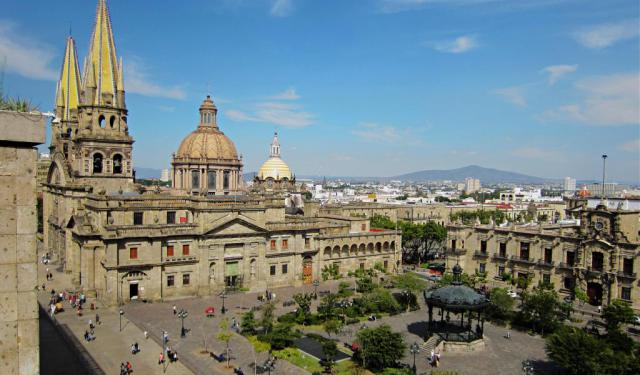
Hospicio Cabañas (Cabañas Orphanage), Guadalajara (must see)
The Bishop of Guadalajara founded the Cabanas Orphanage in the 1700s. Architect Manuel Tolsa designed the current building, which opened in 1810. The orphanage was named after Juan Ruiz de Cabanas, who oversaw the orphanage's construction. The orphanage was built to function as a hospital, workhouse, orphanage, and almshouse. It housed 500 children at a time.
The orphanage was built as a single-level building to make moving children, patients, and the elderly easy. Most of the building is 7.5 meters high (25 feet), but the chapel's dome rises to 32.5 meters high (107 feet). The orphanage's exterior features six Doric columns. The interior has 23 courtyards that are surrounded by hallways.
The building continued to function as a hospital until 1980 when the Cabanas Cultural Institute took over. Hospicio Cabana was designated a UNESCO World Heritage Site in 1997.
Visitors can see several impressive artworks and frescoes in the Cabana Orphanage. The interior features dozens of frescoes painted by renowned Mexican artist Jose Clemente Orozco. One such fresco is the celebrated The Man of Fire, painted between 1936 and 1939. In this mural, a human figure is wreathed in flames, and figures resembling zombies watch from below.
In 2014, Daniel Buren created a series of artworks in the orphanage's courtyards. Buren painted geometric shapes and used bright colors and mirrored structures to distort the traditional surroundings.
Artist Alejandro Colunga created two impressive sculptures outside the orphanage. The sculptures are called The Hall of the Magicians (La Sala de Los Magos) and The Universal Wizards (Los Magos Universales).
The orphanage was built as a single-level building to make moving children, patients, and the elderly easy. Most of the building is 7.5 meters high (25 feet), but the chapel's dome rises to 32.5 meters high (107 feet). The orphanage's exterior features six Doric columns. The interior has 23 courtyards that are surrounded by hallways.
The building continued to function as a hospital until 1980 when the Cabanas Cultural Institute took over. Hospicio Cabana was designated a UNESCO World Heritage Site in 1997.
Visitors can see several impressive artworks and frescoes in the Cabana Orphanage. The interior features dozens of frescoes painted by renowned Mexican artist Jose Clemente Orozco. One such fresco is the celebrated The Man of Fire, painted between 1936 and 1939. In this mural, a human figure is wreathed in flames, and figures resembling zombies watch from below.
In 2014, Daniel Buren created a series of artworks in the orphanage's courtyards. Buren painted geometric shapes and used bright colors and mirrored structures to distort the traditional surroundings.
Artist Alejandro Colunga created two impressive sculptures outside the orphanage. The sculptures are called The Hall of the Magicians (La Sala de Los Magos) and The Universal Wizards (Los Magos Universales).
Want to visit this sight? Check out these Self-Guided Walking Tours in Guadalajara. Alternatively, you can download the mobile app "GPSmyCity: Walks in 1K+ Cities" from Apple App Store or Google Play Store. The app turns your mobile device to a personal tour guide and it works offline, so no data plan is needed when traveling abroad.
Hospicio Cabañas (Cabañas Orphanage) on Map
Sight Name: Hospicio Cabañas (Cabañas Orphanage)
Sight Location: Guadalajara, Mexico (See walking tours in Guadalajara)
Sight Type: Attraction/Landmark
Guide(s) Containing This Sight:
Sight Location: Guadalajara, Mexico (See walking tours in Guadalajara)
Sight Type: Attraction/Landmark
Guide(s) Containing This Sight:
Walking Tours in Guadalajara, Mexico
Create Your Own Walk in Guadalajara
Creating your own self-guided walk in Guadalajara is easy and fun. Choose the city attractions that you want to see and a walk route map will be created just for you. You can even set your hotel as the start point of the walk.
Historical Center Walk
Guadalajara is a modern, bustling metropolis with a long history. It was founded in 1542 as part of New Spain. The town was named after Spanish conquistador Nuno de Guzman’s hometown in Spain.
The city became Mexican state Jalisco’s largest city and its capital. The town boomed during the 17th century, and it became the nation's second-largest city during the 18th century. Miguel... view more
Tour Duration: 2 Hour(s)
Travel Distance: 1.9 Km or 1.2 Miles
The city became Mexican state Jalisco’s largest city and its capital. The town boomed during the 17th century, and it became the nation's second-largest city during the 18th century. Miguel... view more
Tour Duration: 2 Hour(s)
Travel Distance: 1.9 Km or 1.2 Miles
Squares of Guadalajara
The historic center of Guadalajara is the oldest part of the city, a place where it was founded. The abundance of handsome colonial landmarks here – old buildings, public parks and squares (plazas) – makes the area truly magnificent. The plazas – popular gathering spots filled with fountains, statues, benches and food stalls – are particularly great for having a break, watching people and... view more
Tour Duration: 1 Hour(s)
Travel Distance: 1.3 Km or 0.8 Miles
Tour Duration: 1 Hour(s)
Travel Distance: 1.3 Km or 0.8 Miles
Guadalajara Historical Churches Walking Tour
Guadalajara, Mexico, is home to a great number of wonderful religious sites, dating back to the colonial era. Many of them are unique architectural treasures, with striking façades and equally impressive interiors.
The Expiatory Church, characterized by its neo-Gothic design, is a striking landmark dedicated to expiation and reparation. Meanwhile, the Our Lady of the Pilar Church boasts... view more
Tour Duration: 2 Hour(s)
Travel Distance: 3.1 Km or 1.9 Miles
The Expiatory Church, characterized by its neo-Gothic design, is a striking landmark dedicated to expiation and reparation. Meanwhile, the Our Lady of the Pilar Church boasts... view more
Tour Duration: 2 Hour(s)
Travel Distance: 3.1 Km or 1.9 Miles



